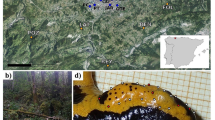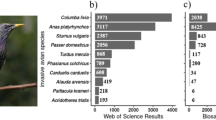Abstract
The adaptive value of correlations among phenotypic traits depends on the prevailing environmental conditions. Differences in selection pressures during species range expansions may therefore shape phenotypic integration. In this study, we assessed variation in behavioral and morphological traits, as well as their covariations, in replicated southern and northern European populations of the northward expanding dragonfly Crocothemis erythraea. Larvae from northern populations were, on average, darker in color, and therefore, better camouflaged than larvae from southern populations. However, there was no difference in activity level. Darkness and activity were positively correlated in larvae from northern populations, whereas this trait covariation was missing in southern populations. This suggests the emergence of alternative strategies in time-limited northern populations, a higher activity level that required better camouflage through darker coloration, while less active larvae benefited from an energy-saving strategy by reducing the investment in costly traits, such as body darkness. We further found that larger larvae emerged into larger adults, with a higher investment in flight morphology. Our findings imply that phenotypic integration is associated with the northward range shift, potentially differentially shaping fitness consequences, and ecological interactions in southern versus northern populations.



Similar content being viewed by others
References
Armitage SAO, Siva-Jothy MT (2005) Immune function responds to selection for cuticular colour in Tenebrio molitor. Heredity 94:650–656. https://doi.org/10.1038/sj.hdy.6800675
Aubret F, Shine R (2009) Genetic assimilation and the postcolonization erosion of phenotypic plasticity in island tiger snakes. Curr Biol 19:1932–1936. https://doi.org/10.1016/j.cub.2009.09.061
Bauhus S (1996) Funde von Crocothemis erythraea (Brullé) und Aeshna affinis (Vanderlinden) in der Lippe-Aue (Anisoptera: Libellulidae, Aeshnidae). Libellula 15:79–84
Beckerman AP, Petchey OL, Morin PJ (2010) Adaptive foragers and community ecology: linking individuals to communities and ecosystems. Funct Ecol 24:1–6. https://doi.org/10.1111/j.1365-2435.2009.01673.x
Bell AM, Sih A (2007) Exposure to predation generates personality in threespined sticklebacks (Gasterosteus aculeatus). Ecol Lett 10:828–834. https://doi.org/10.1111/j.1461-0248.2007.01081.x
Benke AC (1970) A method for comparing individual growth rates of aquatic insects with special references to the Odonata. Ecology 51:328–331. https://doi.org/10.2307/1933673
Bonner JT (2006) Why size matters: from bacteria to blue whales. Princeton Univ. Press., Princeton
Brockaus T, Roland H-J, Benken T et al (2015) Atlas der libellen Deutschlands (Odonata). Libellula Suppl 14:1–394
Carere C, Gherardi F (2013) Animal personalities matter for biological invasions. Trends Ecol Evol 28:5–6. https://doi.org/10.1016/j.tree.2012.10.006
Chen IC, Hill JK, Ohlemuller R et al (2011) Rapid range shifts of species associated with high levels of climate warming. Science 333:1024–1026. https://doi.org/10.1126/science.1206432
Chevin L, Lande R, Mace GM (2010) Adaptation, plasticity and extinction in a changing environment: towards a predictive theory. PLoS Biol 8:1–8. https://doi.org/10.1371/journal.pbio.1000357
Chuang A, Peterson CR (2016) Expanding population edges: theories, traits, and trade-offs. Glob Change Biol 22:494–512. https://doi.org/10.1111/gcb.13107
Clusella Trullas S, van Wyk JH, Spotila JR (2007) Thermal melanism in ectotherms. J Therm Biol 32:235–245. https://doi.org/10.1016/j.jtherbio.2007.01.003
Cordero A (1991) Fecundity of Ischnura graellsii (Rambur) in the laboratory (Zygoptera: Coenagrionidae). Odonatologica 20:37–44
Cote J, Clobert J, Brodin T et al (2010) Personality-dependent dispersal: characterization, ontogeny and consequences for spatially structured populations. Philos Trans R Soc B-Biol Sci 365:4065–4076. https://doi.org/10.1098/rstb.2010.0176
Côte J, Boniface A, Blanchet S, Hendry AP, Gasparini J, Jacquin L (2018) Melanin-based coloration and host-parasite interactions under global change. Proc Roy Soc B. 285(1879):20180285
Cόrdoba-Aguilar A (2008) Dragonflies and damselflies: model organisms for ecological and evolutionary theory. Oxford Univ Press, Oxford
De Block M, Stoks R (2003) Adaptive sex-specific life history plasticity to temperature and photoperiod in a damselfly. J Evol Biol 16:986–995
De Block M, Stoks R (2007) Flight-related body morphology shapes mating success in a damselfly. Anim Behav 74:1093–1098. https://doi.org/10.1016/j.anbehav.2007.01.023
De Block M, Slos S, Johansson F, Stoks R (2008) Integrating life history and physiology to understand latitudinal size variation in a damselfly. Ecography 31:115–123. https://doi.org/10.1111/j.2007.0906-7590.05313.x
Deknijf G (1995) Crocothemis erythraea en Cercion lindenii, nu al in België en binnenkort ook in Nederland algemeen? Libellennieuwsbrief 4:7–12
Dijkstra K-DB (2006) Field guide to the dragonflies of Britain and Europe. British Wildlife Publishing, Devon
Dingemanse NJ, Wright J, Kazem AJN et al (2007) Behavioral syndromes differ predictably between 12 populations of three-spined stickleback. J Anim Ecol 76:1128–1138. https://doi.org/10.1111/j.1365-2656.2007.01284.x
Dommanget JL (1987) Etude faunistique et bibliographique des Odonates de France. Secrétariat Faune/Flore Paris
Endler J (1995) Multiple-trait coevolution and environmental gradients in guppies. Trends Ecol Evol 10:22–29. https://doi.org/10.1016/S0169-5347(00)88956-9
Fedorka KM, Copeland EK, Winterhalter WE (2013) Seasonality influences cuticle melanization and immune defense in a cricket: support for a temperature-dependent immune investment hypothesis in insects. J Exp Biol 216:4005–4010. https://doi.org/10.1242/jeb.091538
Futahashi R (2016) Color vision and color formation un dragonflies. Curr Opin Insect Sci 17:32–39. https://doi.org/10.1016/j.cois.2016.05.014
Garcia TS, Straus R, Sih A (2003) Temperature and ontogenetic effects on color change in the larval salamander species Ambystoma barbouri and Ambystoma texanum. Can J Zool-Rev Can Zool 81:710–715. https://doi.org/10.1139/Z03-036
García-de-Lomas J, Vilà M (2015) Lists of harmful alien organisms: are the national regulations adapted to the global world? Biol Invasions 17:3081–3091. https://doi.org/10.1007/s10530-015-0939-7
Gaston KJ (2009) Geographic range limits: achieving synthesis. Proc R Soc B-Biol Sci 276:1395–1406. https://doi.org/10.1098/rspb.2008.1480
González-Santoyo, Córdoba-Aguilar (2012) Phenoloxidase: a key component of the insect immune system. Entomol Exp Appl 142:1–16. https://doi.org/10.1111/j.1570-7458.2011.01187.x
Hardie DC, Hutchings JA (2010) Evolutionary ecology at the extremes of species’ ranges. Environ Rev 18:1–20. https://doi.org/10.1139/a09-014
Hill JK, Griffiths HM, Thomas CD (2011) Climate change and evolutionary adaptations at species’ range margins. Annu Rev Entomol 56:143–159. https://doi.org/10.1146/annurev-ento-120709-144746
Hodgetts RB, O’Keefe SL (2006) Dopa decarboxylase: a model gene-enzyme system for studying development, behavior, and systematics. Annu Rev Entomol 51:259–284. https://doi.org/10.1146/annurev.ento.51.110104.151143
Hughes CL, Dytham C, Hill JK (2007) Modelling and analyzing evolution of dispersal in populations at expanding range boundaries. Ecol Entomol 32:437–445
Kim S-Y, Velando A (2015) Phenotypic integration between antipredator behavior and camouflage pattern in juvenile sticklebacks. Evolution 69:830–838. https://doi.org/10.1111/evo.12600
Lohr M (2003) Crocothemis erythraea auch in Niedersachsen (Odonata: Libellulidae). Libellula 22:35–39
Mafli A, Wakamatsu K, Roulin A (2011) Melanin-based coloration predicts aggressiveness and boldness in captive eastern Hermann’s tortoises. Anim Behav 81:859–863. https://doi.org/10.1016/j.anbehav.2011.01.025
Marden JH, Rowan B (2000) Growth, differential survival, and shifting sex ratio of free-living Libellula pulchella (Odonata: Libellulidae) dragonflies during adult maturation. Ann Entomol Soc Am 93:452–458. https://doi.org/10.1603/0013-8746
Oberski DL (2014) lavaan.survey: an R package for complex survey analysis of structural equation models. J Stat Softw 57(1):1–27
Ott J (2007) The expansion of Crocothemis erythraea (Brullé, 1832) in Germany – an indicator of climatic changes. In: Tyagi BK (ed) Biology of dragonflies. Scientific Publishers, Jodhpur
Phillips BL, Brown GP, Shine R (2010) Life-history evolution in range-shifting populations. Ecology 91:1617–1627. https://doi.org/10.1890/09-0910.1
Pinkert, S, Brandl R, Zeuss D (2016) Colour lightness of dragonfly assemblages across North America and Europe. Ecography. https://doi.org/10.1111/ecog.02578
Pintor LM, Sih A, Bauer ML (2008) Differences in aggression, activity and boldness between native and introduced populations of an invasive crayfish. Oikos 117:1629–1636. https://doi.org/10.1111/j.1600-0706.2008.16578.x
R Core Team (2013) R: A language and environment for statistical computing. R Foundation for Statistical Computing, Vienna
Raffard A, Cucherousset J, Prunier JG, Loot G, Santoul F, Blanchet S (2019) Variability of functional traits and their syndromes in a freshwater fish species (Phoxinus phoxinus): the role of adaptive and non-adaptive processes. Ecol Evolut 9:2833–2846
Roff DA, Fairbairn DJ (2012) The evolution of trade-offs under directional and correlational selection. Evolution 66:2461–2474. https://doi.org/10.1111/j.1558-5646.2012.01634.x
Roff DA, Fairbairn DJ (2013) The costs of being dark: the genetic basis of melanism and its association with fitness-related traits in the sand cricket. J Evol Biol 26:1406–1416. https://doi.org/10.1111/jeb.12150
Schilder RJ, Marden JH (2004) A hierarchical analysis of the scaling of force and power production by dragonfly flight motors. J Exp Biol 207:767–776. https://doi.org/10.1242/jeb.00817
Stamps JA (2007) Growth-mortality tradeoffs and ‘personality traits’ in animals. Ecol Lett 5:355–363
Stoks R, Cόrdoba-Aguilar A (2012) Evolutionary ecology of Odonata: a complex life cycle perspective. Ann Rev Entomol 57:249–265
Therry L, Lefevre E, Bonte D, Stoks R (2014a) Increased activity and growth rate in the non-dispersive aquatic larval stage of a damselfly at an expanding range edge. Freshw Biol 59:1266–1277. https://doi.org/10.1111/fwb.12346
Therry L, Nilsson-Örtman V, Bonte D, Stoks R (2014b) Rapid evolution of larval life history, adult immune function and flight muscles in a poleward-moving damselfly. J Evol Biol 27:141–152. https://doi.org/10.1111/jeb.12281
Therry L, Gyulavari HA, Schillewaert S et al (2014c) Integrating large-scale geographic patterns in flight morphology, flight characteristics and sexual selection in a range-expanding damselfly. Ecography 37:1012–1021. https://doi.org/10.1111/ecog.00630
Therry L, Bonte D, Stoks R (2015) Higher investment in flight morphology does not trade off with fecundity estimates in a poleward range-expanding damselfly. Ecol Entomol 40:133–142
Therry L, Cote J, Cucherousset J et al (2019) Genetic and environmental contributions to the impact of a range-expanding predator on aquatic ecosystems. J Anim Ecol. https://doi.org/10.1111/1365-2656.12938
True JR (2003) Insect melanism: the molecules matter. Trends Ecol Evol 18:640–647. https://doi.org/10.1016/j.tree.2003.09.006
Valiente AG, Juanes F, Nunez P, Garcia-Vazquez E (2010) Brown trout (Salmo trutta) invasiveness: plasticity in life-history is more important than genetic variability. Biol Invasions 12:451–462. https://doi.org/10.1007/s10530-009-9450-3
van Oers K, Mueller JC (2010) Evolutionary genomics of animal personality. Phil Trans R Soc B 365(1560):3991–4000
Verhoog MD, Breuker CJ, Brakefield PM (1998) The influence of genes for melanism on the activity of the flour moth, Ephestia kuehniella. Anim Behav 56:683–688. https://doi.org/10.1006/anbe.1998.0801
Werner EE, Anholt BR (1993) Ecological consequences of the trade-off between growth and mortality-rates mediated by foraging activity. Am Nat 142:242–272. https://doi.org/10.1086/285537
Zeuss D, Brandl R, Brändle M, Rahbek K, Brunzel S (2014) Global warming favours light-coloured insects in Europe. Nat Com 5:3874
Acknowledgements
We kindly thank the people that guided us to populations and helped collecting the samples: Yohan Morizet, Philippe Lambret, Charlotte Sohier, Hajnalka Gyulavári, Diana Goertzen and Frank Suhling. ANB-Belgium, Indre Nature, Grand Port Maritime de Marseille and Département Environnement et Aménagement provided permission and access to populations. This study is part of the project PROBIS (Biodiversa) and financially supported by ONEMA, DFG and SEPA. JC is supported by an ANR-12-JSV7-0004-01. JC and SB are part of the Laboratoire d’Excellence (LABEX) entitled TULIP (ANR-10-LABX-41).
Author information
Authors and Affiliations
Contributions
LT, FF, SB and JC conceived and designed the experiment. LT, FF and KK conducted fieldwork and performed the experiment. LT and AR analyzed the data with input from SB and JC. LT wrote the first draft, AR wrote the revised version and all authors contributed to these versions.
Corresponding author
Ethics declarations
All applicable institutional and/or national guidelines for the care and use of animals were followed.
Conflict of interest
The authors declare they have no conflict of interest.
Additional information
Communicated by Thomas S. Hoffmeister.
Electronic supplementary material
Below is the link to the electronic supplementary material.
Rights and permissions
About this article
Cite this article
Raffard, A., Therry, L., Finn, F. et al. Does range expansion modify trait covariation? A study of a northward expanding dragonfly. Oecologia 192, 565–575 (2020). https://doi.org/10.1007/s00442-020-04592-1
Received:
Accepted:
Published:
Issue Date:
DOI: https://doi.org/10.1007/s00442-020-04592-1




